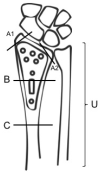Peri-Implant Distal Radius Fracture: Proposal of a New Classification
- PMID: 35566755
- PMCID: PMC9105785
- DOI: 10.3390/jcm11092628
Peri-Implant Distal Radius Fracture: Proposal of a New Classification
Abstract
A peri-implant fracture near the volar plate of the distal radius represents a rarity and can be associated with a mechanical failure of the devices. A literature review was conducted including all fractures that occurred around a volar wrist plate, which could be associated with an ulna fracture. All articles published until December 2021 were considered according to the guidelines presented in the PRISMA Statement. The search was conducted with the PubMed electronic database, Cochrane Database of Systematic Reviews, Medline, Embase, and Google Scholar. Only nine cases of these fractures were reported in the literature. The causes could be due to delayed union/non-union of the old fracture after low energy traumas, high energy trauma in patients with poor bone quality, or hardware mechanical failure. Furthermore, the literature review of peri-implant radius fracture shows different level of radius fracture and types of implant failure. In accordance with these different cases, a new classification of peri-implant fracture of the distal radius is proposed.
Keywords: peri-implant fracture; plate bending; plate breakage; wrist fracture.
Conflict of interest statement
The authors declare that they have no conflict of interest.
Figures
References
-
- Foo T.L., Gan A.W., Soh T., Chew W.Y. Mechanical failure of the distal radius volar locking plate. J. Orthop. Surg. 2013;21:332–336. doi: 10.1177/230949901302100314. - DOI
LinkOut - more resources
Full Text Sources



